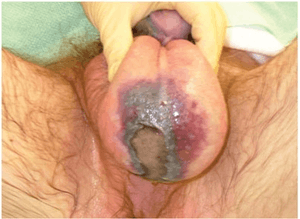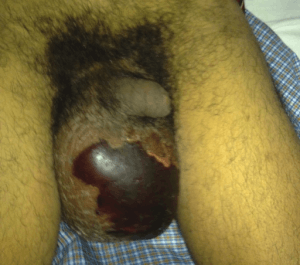Fournier gangrene
Background
- Life-threatening polymicrobial necrotizing fasciitis of perineum, genitalia, or perianal area.
- Mortality - often cited as 20-40%, but up to 80% in some studies[2]
Risk Factors
- Diabetes mellitus (most common)
- Hypertension
- Alcoholism
- Advanced age
- Para/Quadriplegic
- Males>Females (10:1)[1], (likely under-diagnosed in women[2])
Clinical Features

Fournier's Gangrene

ournier's Gangrene
- Initial event is usually local trauma or extension of a UTI or perianal infection[1]
- Gangrene develops over 2-7 days
- Marked pain, localized swelling, crepitus, ecchymosis to genital or perineal area.
- Fever
- Malodorous purulent drainage
- In late or severe cases, patient may present in septic shock
Differential Diagnosis
Evaluation
Work-up
- CBC - very elevated leukocytosis
- CMP - hyponatremia
- ESR
- CRP
- Lactate
- Type and Screen
- Wound Culture
- Blood Cultures
- CT Abdomen/pelvis (only if diagnosis unclear or if requested by surgery/urology)
Evaluation
- Clinical diagnosis, based on history and physical exam
- LRINEC score here: Necrotizing fasciitis
Management
- Immediate surgery and urology consult for surgical debridement (gangrene can spread at rate of 2-3 cm/hr[1])
- Antibiotics - Must cover gram positive, gram negative, and anaerobes
- Vancomycin + (imipenem 1gm IV q24hr OR meropenem 500mg-1gm IV q8hr OR piperacillin-tazobactam 3.375gm to 4.5gm IV q6h) +/- (clindamycin 600mg-900mg IV q8h OR metronidazole 1gm IV then 500mg IV q8h)
- Aggressive supportive care, including fluid resuscitation (and pressors, if indicated)
Disposition
- Admit to ICU
See Also
References
- Shyam DC, Rapsang AG. Fournier's gangrene. Surgeon. 2013 Aug;11(4):222-32. doi: 10.1016/j.surge.2013.02.001.
- Wróblewska M et al. Fournier's gangrene: current concepts. Pol J Microbiol. 2014;63(3):267-73.
This article is issued from
Wikem.
The text is licensed under Creative
Commons - Attribution - Sharealike.
Additional terms may apply for the media files.